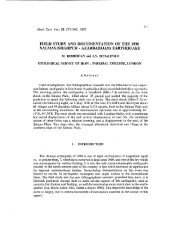PDF COPY - Manuel berberian
PDF COPY - Manuel berberian
PDF COPY - Manuel berberian
You also want an ePaper? Increase the reach of your titles
YUMPU automatically turns print PDFs into web optimized ePapers that Google loves.
M. Berberian, R.S. Yeats / Journal of Structural Geology 23 (2001) 563±584 573Fig. 5. Active tectonic map (located in Fig. 1) of the Ashkabad area. Faults are drawn from the satellite imagery (Landsat-TM, 160 and 161/034, 1987, 1988).Isoseismals (MSK) of the 1948 (M s 7.2) earthquake in Turkmenistan based on Medvedev (1955) and Gorshkov (1957), Medvedev (1961), and in Iran, based onTchalenko (1975) and this study. The approximate location of the co-seismic extension surface fractures is shown by a thick line striking N308E east of KuruGaudan village (large circle) on the Kuru Gaudan±Zarineh Kuh anticline above the hanging wall block of the Gyaurs surface thrust and blind thrust faults.Fault plane solution of the AD 1948 earthquake after McKenzie (1972). Meizoseismal area of the 1966 earthquake at Kakhka (Qahqaheh, NE of Namazgamound) after Bune and Gorshkov (1980). Archaeological sites (Kohl and Heskel, 1980; Zadneprovsky, 1995) are shown by ®lled triangles. Fault symbols areas in Fig. 1. Exact location of Ak Tapeh mound is uncertain, since Kondorskaya and Shebalin (1977, 1982) locate it to the NW of Ashkabad, while Golinsky(1977, 1982) locates it 18 km NE of Ashkabad (we choose the latter).the Manjil reverse fault is located 12.5 km to the south of themound (Fig. 4). Accordingly, the 3000-year `maximumrecurrence interval' refers to the region (an `area source'),since the earlier earthquake could have ruptured one of thereverse faults rather than the Rudbar strike-slip fault.Rupture of the Daylaman reverse fault during this periodis less likely because no disruption is reported from HassaniMahaleh mound located about 1000 m north of the fault(Fig. 4). We cannot prove that this site was in continuousoccupation and undamaged throughout the 3000-year timeinterval.5. The main Kopeh Dagh Fault system (Turkmenistan)Ashkabad, the capital city of Turkmenistan, wasdestroyed by an earthquake of M s 7.2 in 1948.10.05 (Fig.5). More than 10,000 people were killed in Turkmenistan,and more than 30 villages were destroyed in Iran, with morethan 350 people killed in the Dareh Gaz region alone. Theearthquake had an intensity of IX (MSK) at Ashkabad,Nesa, and Annau (Fig. 5), and X (MSK) at Kuru Gaudunand Gyaurs (Gorshkov, 1957). This was the strongest earthquaketo strike this region since at least AD 1455, the yearthat the Timurid Shrine of Shaykh Jamal al-Din was builtat Annau (Golombek and Wilber, 1988), 14 km ESE ofAshkabad (Fig. 5). This shrine was reduced to a smallgroup of isolated piers in AD 1948.Although the intensity IX (MSK) isoseismal of the AD1948 earthquake has the form of an NW±SE elongatedellipse parallel to the foothills of the Kopeh Daghmountains, the NW±SE mountain-bordering strike-slipfaults were not reactivated at the surface (Gorshkov, 1957;Koridalin et al., 1961; Medvedev, 1961; Rustanovich andShirokova, 1964). The X and IX (MSK) isoseismals, locatedon the hanging wall block of the Gyaurs surface thrust andblind thrust, follow the trend of the Gyaurs surface fault.However, the VIII (MSK) isoseismal in Iran makes a rightstep to encompass the Naukhandan thrust fault, as if themotion was transferred from one fault to another (Fig. 5;also compare with the Ipak case in Fig. 3). The absence ofsurface rupture may have been due to the absorption ofbrittle faulting by ductile beds, a deeper focal depth, or ablind reverse fault. Tension ®ssure zones hundreds of meterslong and approximately 30 m wide striking N308E werefound at Kuru Gaudan (Fig. 5) 28 km SE of Ashkabad(Gorshkov, 1957; Koop et al., 1964; Gorshkov and Yakushova,1967; Tchalenko, 1975).An NNE±SSW shortening in the southeastern section ofthe meizoseismal area, in the hanging wall block of both theGyaurs blind and surface thrust faults (Fig. 5), is indicatedby: (i) development of an E±W elongated maximum







